Europe is currently leading the shift towards decarbonization of the economy by setting ambitious targets for reducing fossil fuel use. This concept is as beautiful as it is complex, yet it depicts a journey with a destination that can be reached by all Eurozone countries.
In an exercise of ecological leadership over the last five years, numerous measures have emerged to define the best route to take. From the European Green Pact to the Fit for 55 package, targets continue to be extended with increasing specificity. We need to drastically reduce our journey’s greenhouse gas emissions, and our fuels have a lot to say.

The Russian conflict prompted the EU to recalculate the roadmap in 2022 to avoid future unpaved roads on the journey. Since the creation of the REPowerEU plan as a response to phasing out dependence on Russian fossil fuels, the target for renewable energy sources by 2030 has been increased to 45%. In this document, in addition to expanding solar photovoltaic capacity, the importance of biomethane and hydrogen imports is emphasized.
Each member state has set its administrations in motion, in the manner of navigation systems, and the result is numerous routes full of intermediate milestones for achieving the final goal.
THE ROAD TRAVELLED
Like any good journey, the road to the European energy transition begins with a lot of hope in the form of grid electrification and sustainable mobility policies. The generation of renewable electricity through photovoltaic and wind farms has been a great start on our journey. Investment packages to reduce production costs, rapid construction and cost-effective projects, and the direct injection of “green” electricity into the grid. Transmission capacity in Europe has grown steadily in recent years, taking on the first legs of our journey and decarbonizing part of our energy mix through electrification.
After the first few kilometers, we realized that the amount of natural gas consumed in Europe is equivalent to that of electricity, and dependence is higher. Our renewable electricity production capacity needs to be unambiguously complemented by renewable gases to continue our journey.
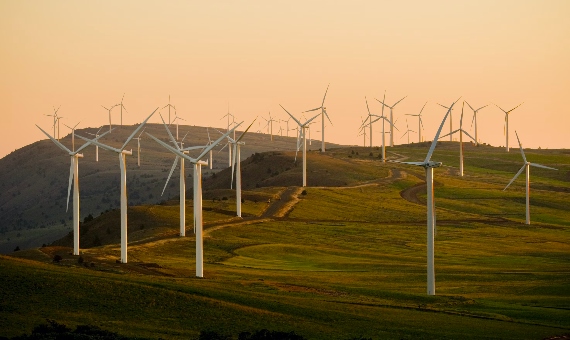
Unlike renewable electricity sources, 83% of natural gas is imported and of fossil origin. A diversified energy mix where energy sources are complementary and non-fossil, presents greater solidity and ensures a sustained supply in the face of geopolitical and financial events.
A dashboard warning light has come on, and all occupants of the vehicle have reached a consensus. To achieve our goals, we urgently need to reduce our dependence on fossil natural gas for three reasons:
- Economic: reducing production costs and the high dependence on gas producers and price volatility in a market that is fragile in the face of stochastic events.
- Social: acquiring energy sovereignty in the gas market means job creation, storage capacity for its supply, public awareness, and lower bills.
- Environmental: it helps us to reduce our GHG emissions decisively, decarbonize the entire fossil natural gas supply chain, take advantage of existing infrastructures, recover materials, and reduce the extraction of raw materials.
DEFINITIVE ROUTE
The renewable gas route has been chosen. It currently presents technical and economic benefits and regulatory compliance in the face of regulations that are likely to become stricter. The challenges of the future are unquestionable, so the current strategy requires a prioritization based on the state-of-the-art of renewable gases. There are 3 renewable gases capable of contributing to decarbonizing Europe: biomethane, syngas and hydrogen.
Biomethane:
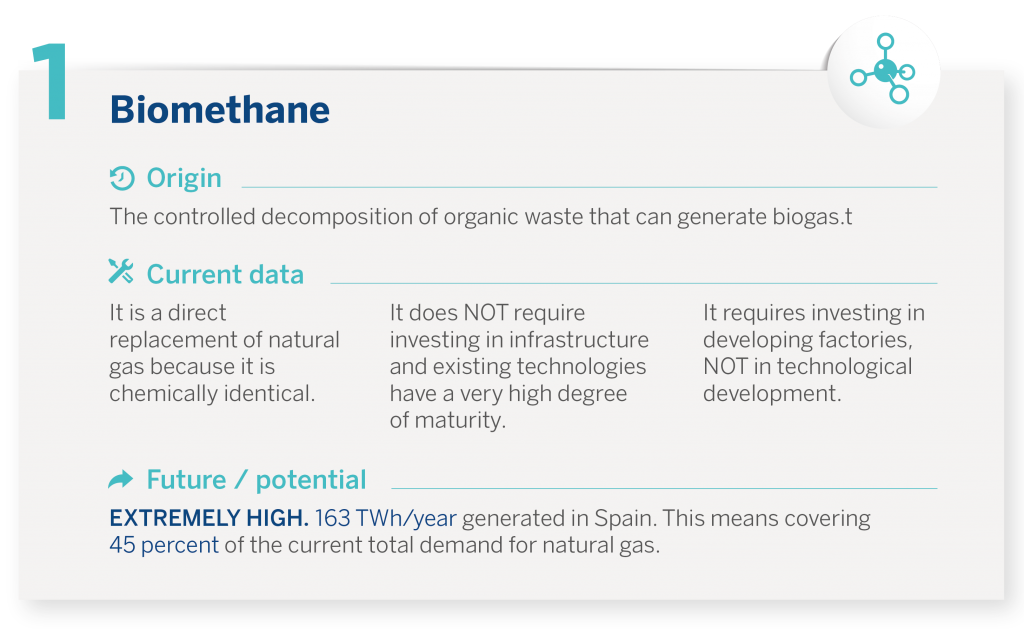
- Its origin is the controlled decomposition of waste such as slurry, sewage or municipal organic waste that generates biogas. Anaerobic digestion of organic waste is the most efficient method for its capture. The biogas produced is characterized by 55-70% methane and 30-45% CO2 and traces of other compounds. This biogas is cleaned through an “upgrading” process, which consists of extracting the CO2 to increase its methane content to over 96%, thus transforming the biogas into biomethane.
- It is a direct replacement for natural gas because it is chemically identical. This means that it does not require investment in infrastructure such as distribution networks, since the existing gas network can be used to transport the biomethane.
- This methane becomes a fuel rather than a pollutant. Methane is a gas with a global warming potential 20 times higher than CO2.
- Existing technologies have a very high degree of maturity and are widely used internationally with proven validity. Europe exceeded 1,000 biomethane plants in 2021 and reached a production of 37 TWh1, equivalent to the consumption of 7 million households. Investment is required in plant development, not in technological development.
- The latest data provided by the Spanish Gas Association (SEDIGAS) reveal a generation potential in Spain of 163 TWh/year2. This means covering 45% of the total demand for natural gas.
- The positive environmental impact on organic waste (higher methane emission points3), the reduction of the carbon footprint throughout the gas value chain and its capillarity, being able to reach homes and industry directly and immediately, make this gas a priority in decarbonization.
Synthetic gas (Syngas):
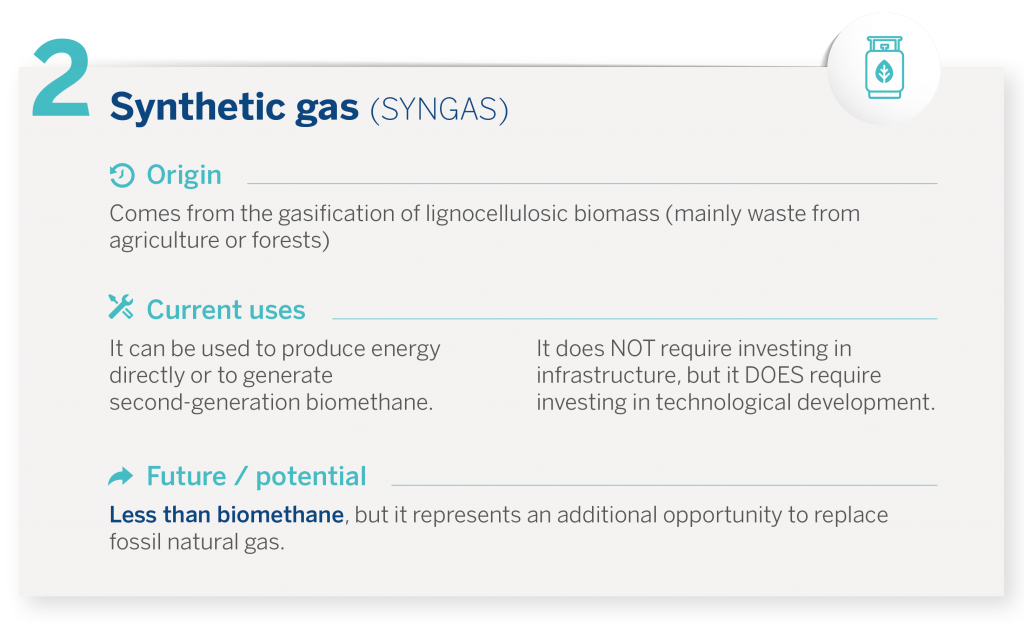
- This gas comes from the gasification of lignocellulosic biomass, mainly agricultural or forestry residues.
- Like biogas, it can be used directly for energy production or cleaned by methanation and upgrading to generate second-generation biomethane.
- There are currently proofs of concept on an industrial scale, but these are technologies that require further technological development to reduce production costs.
- Their development does not require investment in network infrastructure, but it does require investment in technology development, making it a complementary solution in the medium term.
- The generation potential is lower than biomethane, but it represents an additional generation opportunity to displace fossil natural gas.
Hydrogen:
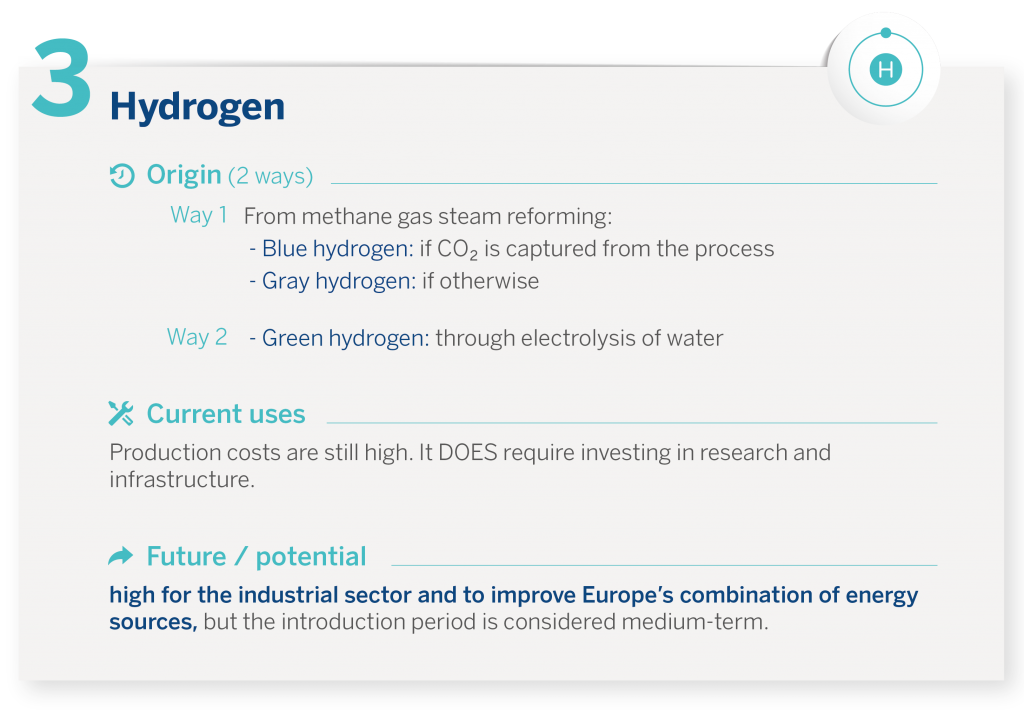
- It can be obtained in 2 ways: From the methane gas steam reforming (blue hydrogen if CO2 is captured from the process, or gray hydrogen otherwise), or through electrolysis of water (Green hydrogen, if the electrolysis works from renewable electricity).
- Its success, particularly green hydrogen, lies in the fact that it is generated from water and the only waste derived from its use is also water.
- It has great potential mainly for the industrial sector.
- Regarding its technological maturity, the first industrial-scale plants are beginning to appear. Despite this, the cost of production is still much higher than other renewable sources, so it requires development4.
- In addition to investment in research and development, the infrastructure for its implementation is also associated with high costs for the time being.
- At present, small percentages (2-5%) of hydrogen can be injected into the natural gas grid, displacing part of the fossil fuel.
- Its potential for improving the European energy mix is very high, but the implementation period is considered to be in the medium term5.
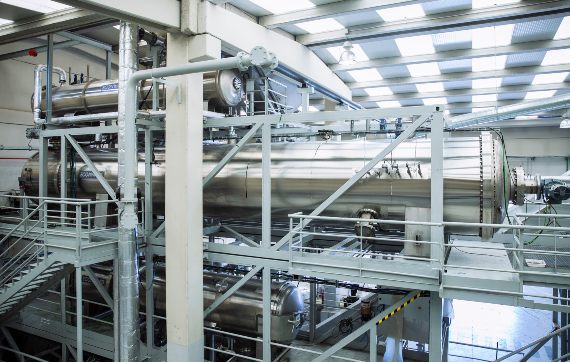
With the route well planned and the fuels selected for the next filling stations, the journey towards our energy goals seems plausible. Traveling the biomethane highway is the only alternative as we construct the hydrogen expressway. Renewable gases are a crucial energy vector for decarbonization, and now we just need to step on the accelerator of public-private investment to keep moving forward and save possible future tolls. Bon voyage!
Pedro Lorenzo Cruz
References
- EBA Statistical Report 2022, https://www.europeanbiogas.eu
- ‘Estudio de la capacidad de producción de biometano en España’, Asociación Española del Gas, Sedigas 2023.
- Methane emissions in the EU: the key to immediate action on climate change, European environment Agency, 2022.
- European Commission, Directorate-General for Research and Innovation, Building a European research area for clean hydrogen : The role of research & innovation investments to deliver on the hydrogen strategy, Publications Office of the European Union, 2022.
- A hydrogen strategy for a climate-neutral Europe.
Comments on this publication